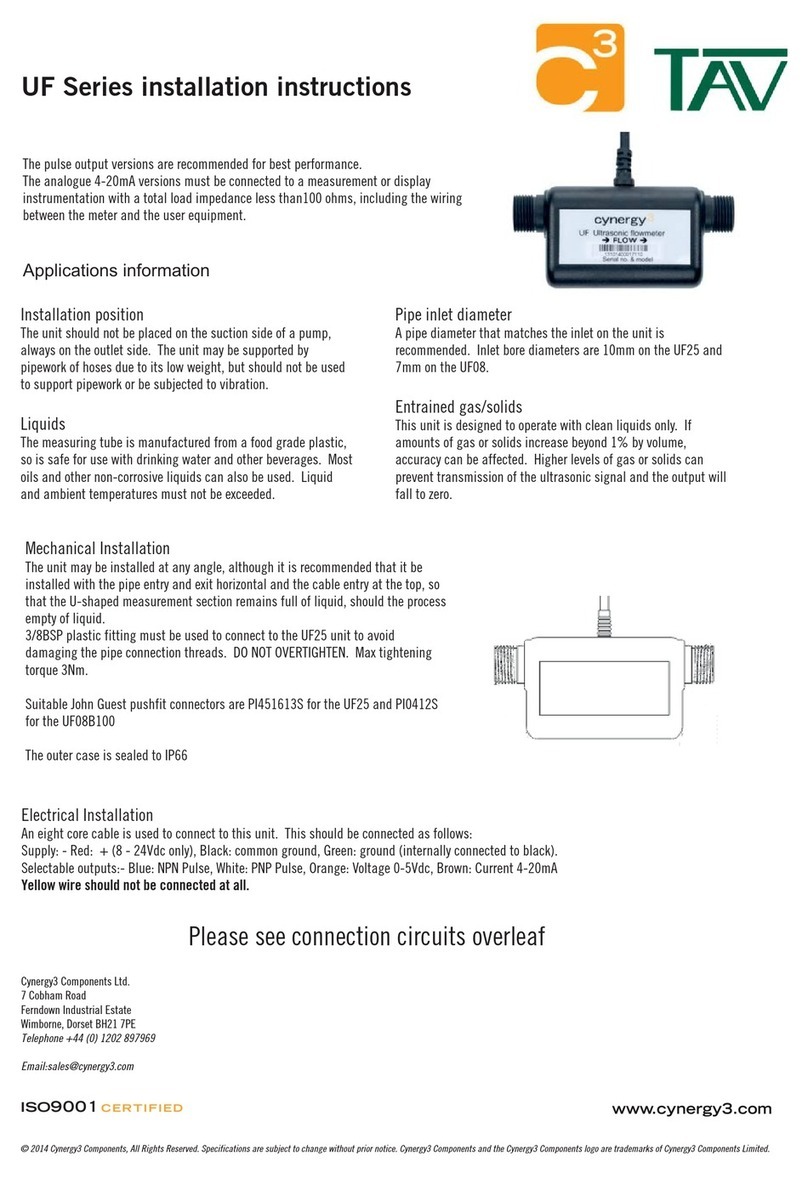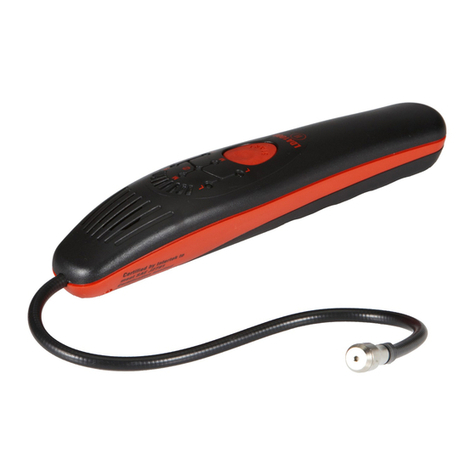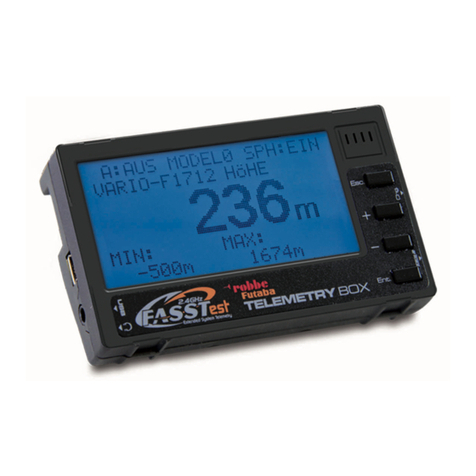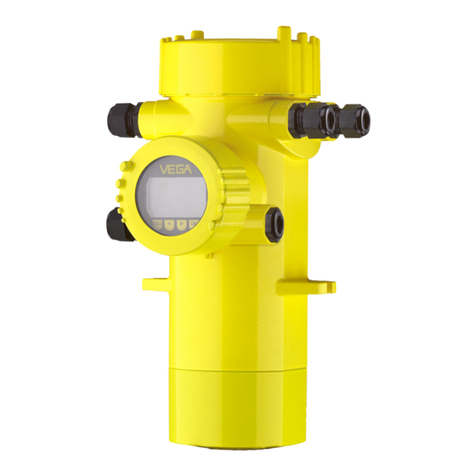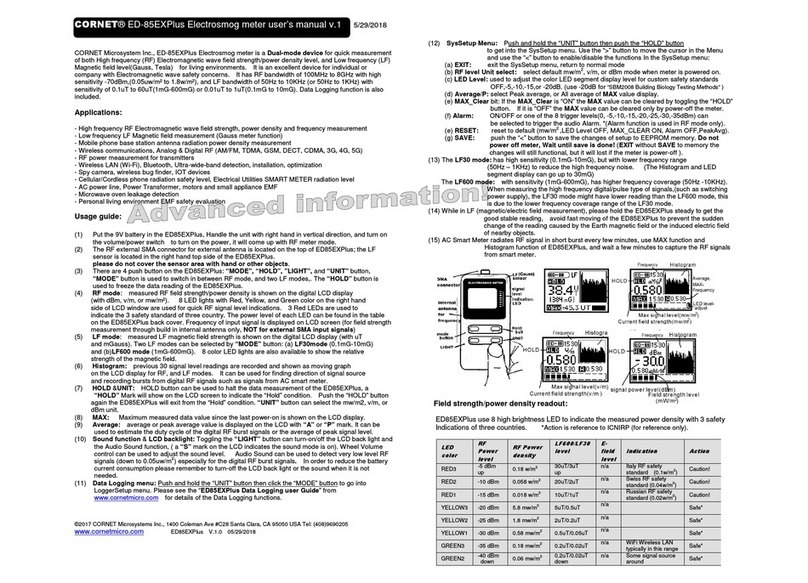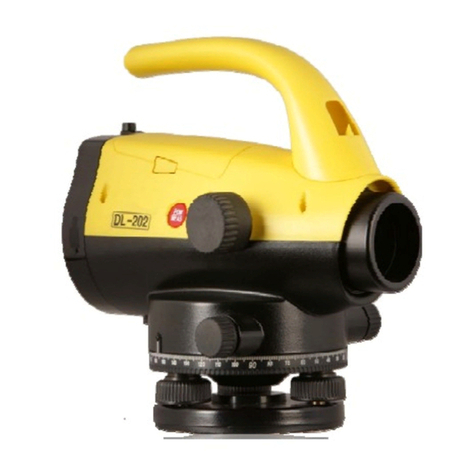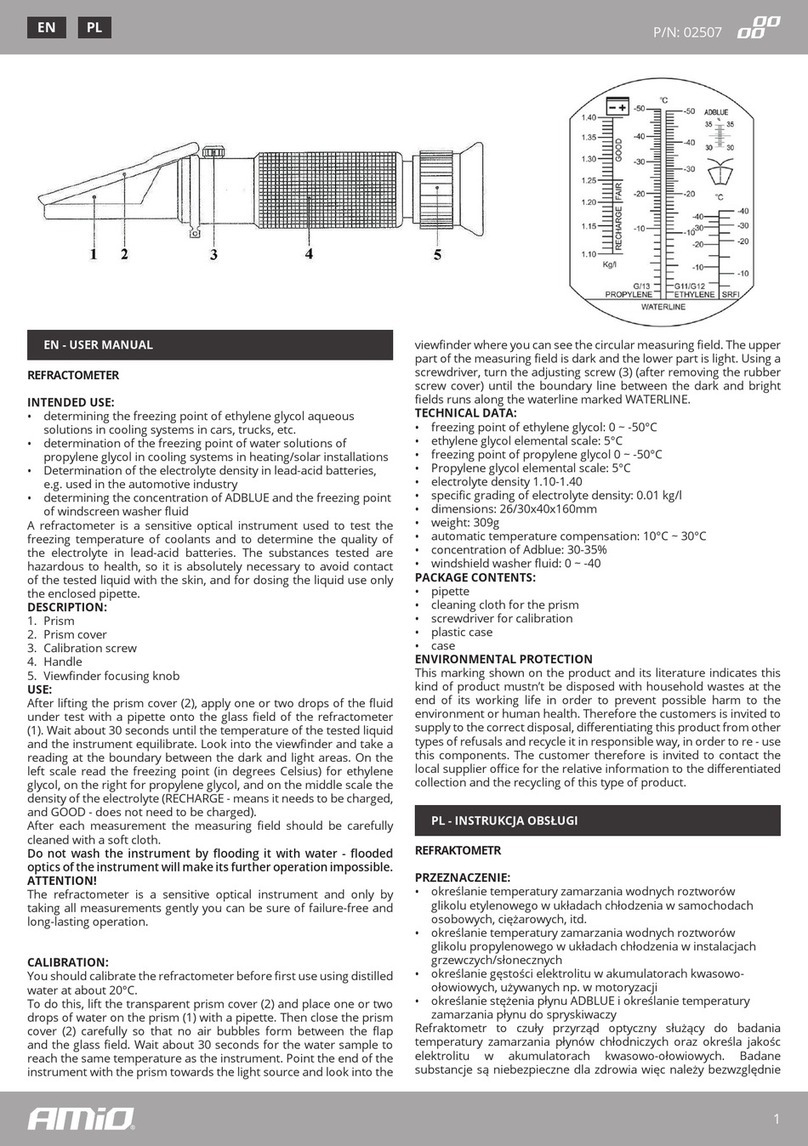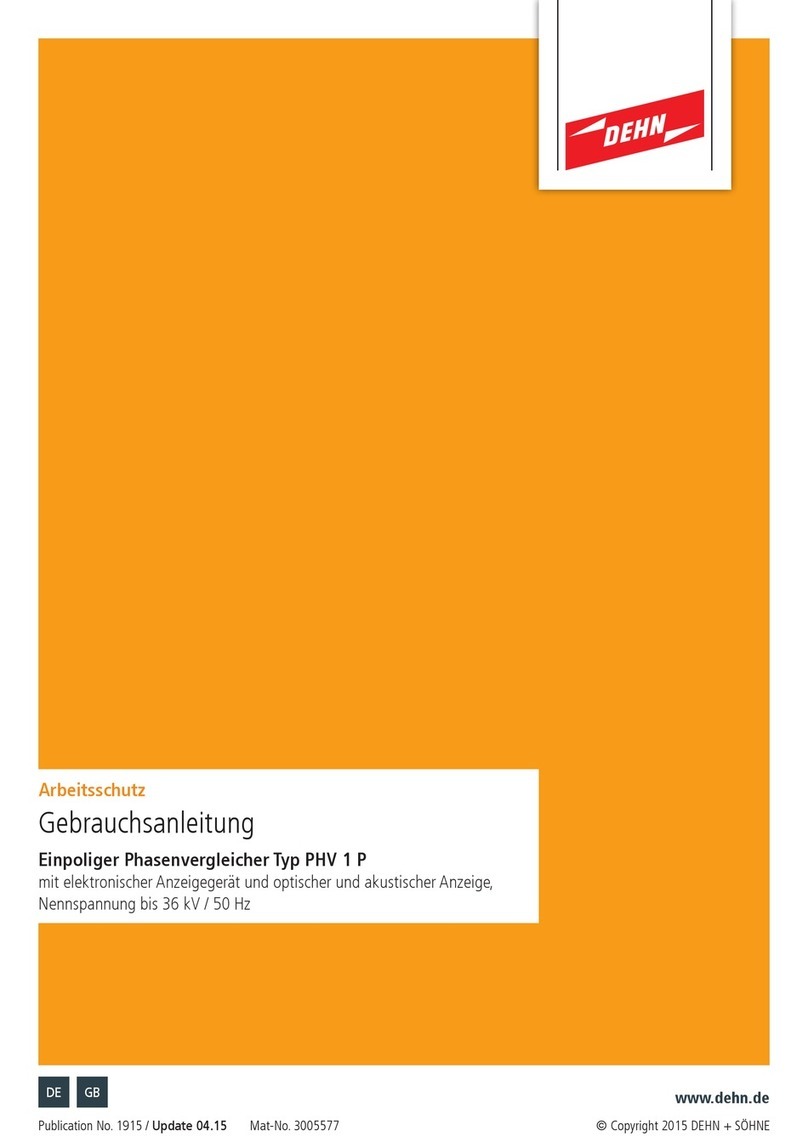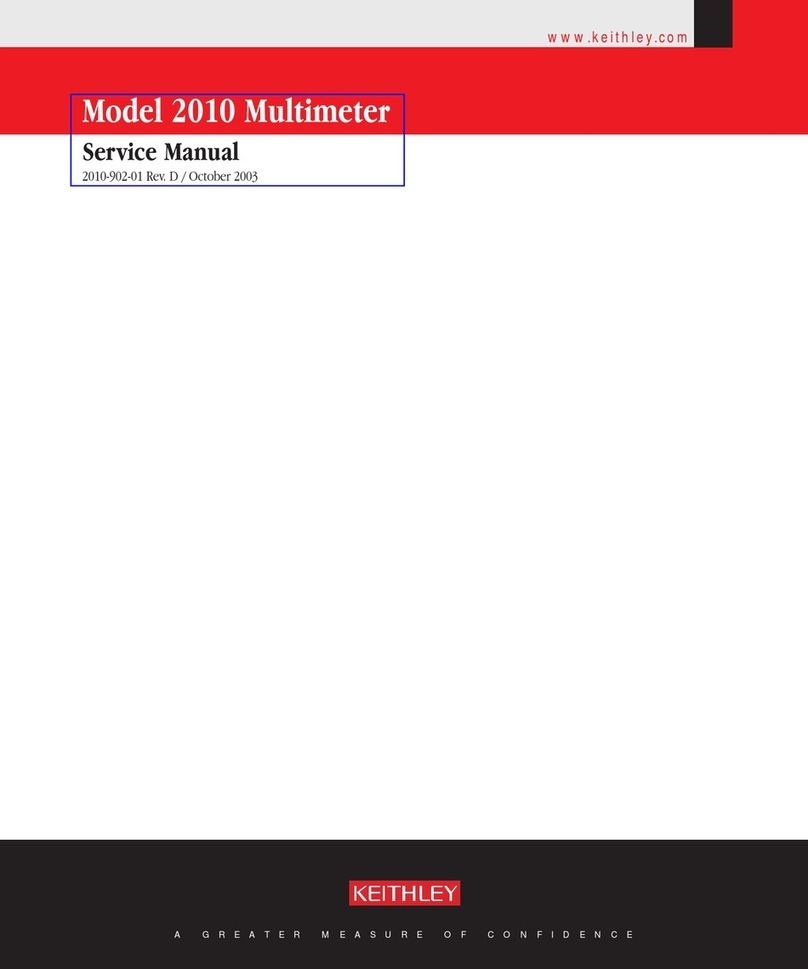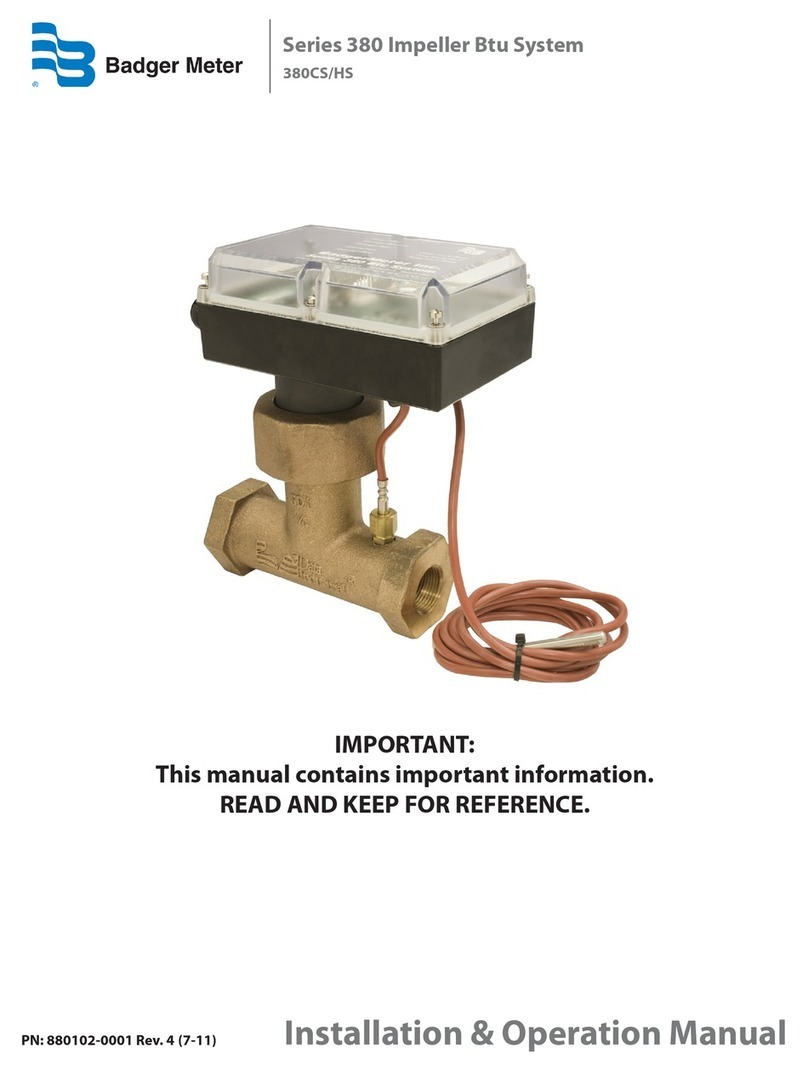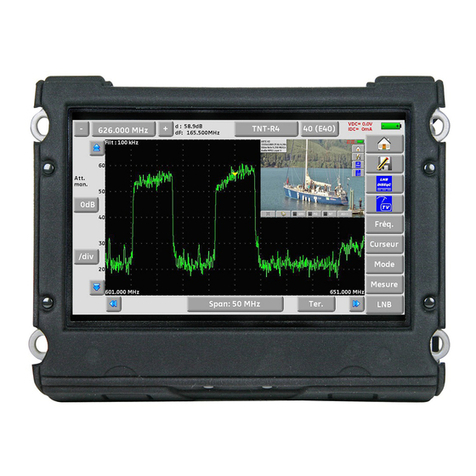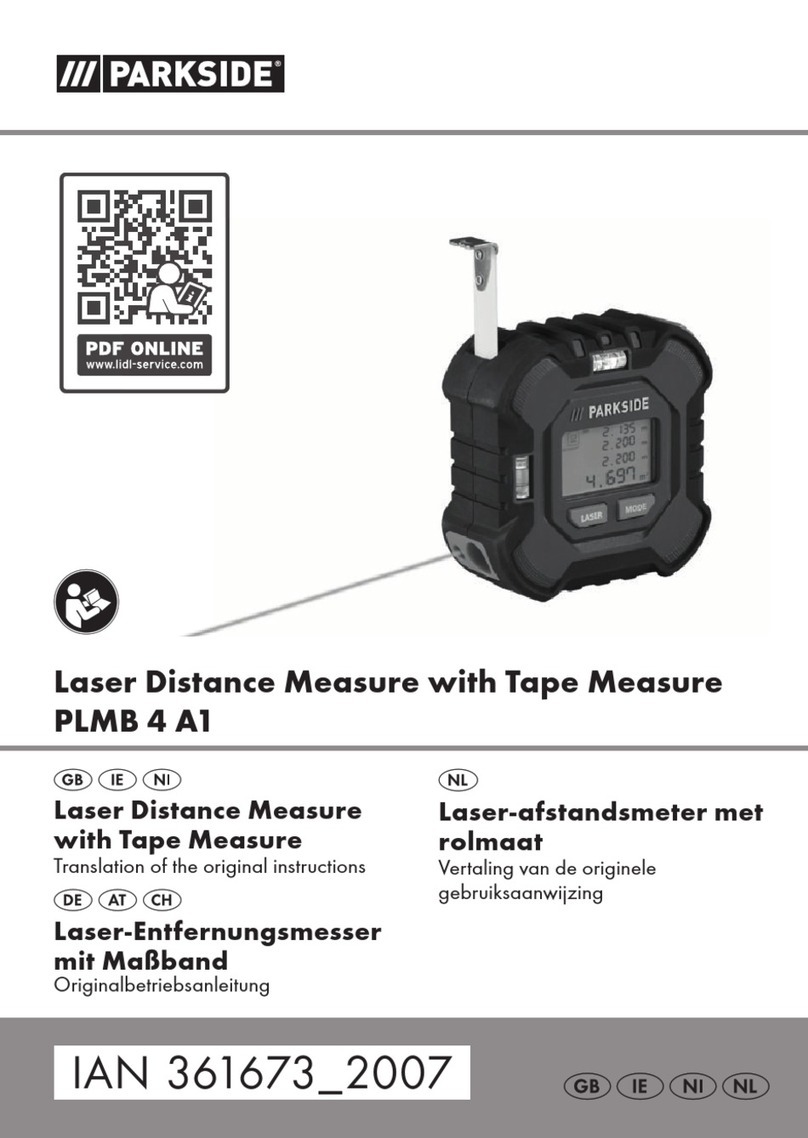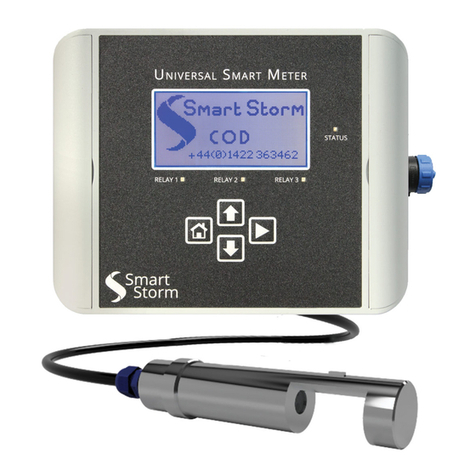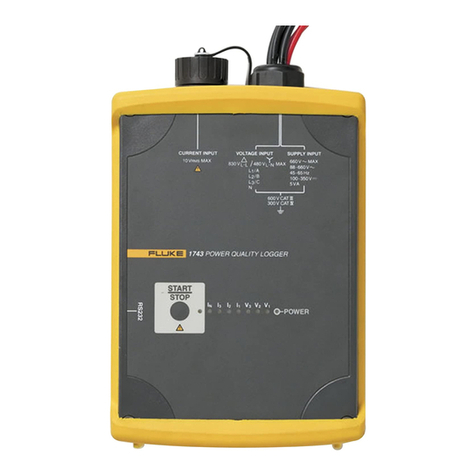Grace Engineered Products GraceSense G-HSM-9SM User manual

HOT SPOT MONITOR (HSM)
INSTALLATION GUIDE
INSTRUCTION BULLETIN NO. HSM-IG-EN

GraceSenseTM Hot Spot Monitor
Contact Information:
Grace Engineered Products, Inc.
1515 E Kimberly Road
Davenport, IA 52807
www.gracesense.com

GraceSenseTM Hot Spot Monitor
Signal Words
As stated in ANSI Z535.4-2007, the signal word is
a word that calls attention to the safety sign and
designates a degree or level of hazard seriousness.
The signal words for product safety signs are
“Danger”, “Warning”, and “Caution”. These
words are defined as:
DANGER indicates an imminently hazardous
situation which, if not avoided, will result in
death or serious injury.
!
DANGER
!
WARNING
WARNING indicates a potentially hazardous
situation which, if not avoided, could result
in death or serious injury.
!
CAUTION
CAUTION, used with the safety alert symbol,
indicates a hazardous situation which, if not
avoided, could result in minor or
moderate injury.
CAUTION, used without the safety alert
symbol, is used to address practices not
related to personal injury.
CAUTION
NOTICE
NOTICE is used to address practices not
related to personal injury.
Qualified Person
For the purposes of this manual, a qualified
person, as stated in NFPA 70E®, is one who has
skills and knowledge related to the construction
and operation of the electrical equipment and
installations and has received safety training to
recognize and avoid the hazards involved. In
addition to the above qualifications, one must
also be:
1. Trained and authorized to energize,
de-energize, clear, ground, and tag circuits
and equipment in accordance with
established safety practices.
2. Trained in the proper care and use of
personal protective equipment (PPE)
such as rubber gloves, hard hat, safety
glasses or face shields, flash clothing, etc.,
in accordance with established safety
practices.
3. Trained in rendering first aid if necessary.

GraceSenseTM Hot Spot Monitor
This page is intentionally left blank.

i
GraceSenseTM Hot Spot Monitor
Contents
Ch 1 General Information ............................................................................................................................ 1
A. Scope ................................................................................................................................................. 2
B. Purpose ............................................................................................................................................. 2
C. Approvals and Certifications .............................................................................................................. 2
1) Safety Information ........................................................................................................................ 2
2) FCC Statement ............................................................................................................................ 2
3) EMC Directive .............................................................................................................................. 2
D. Instruction Bulletins Available Electronically ...................................................................................... 3
Ch 2 Safety ................................................................................................................................................ 4
A. Safe Work Condition .......................................................................................................................... 4
B. Safety Guidelines ............................................................................................................................... 4
C. General .............................................................................................................................................. 5
D. Specific .............................................................................................................................................. 5
E. Safety Labels ..................................................................................................................................... 5
Ch 3 Equipment Description ................................................................................................................... 6
A. General .............................................................................................................................................. 6
B. Sensing System Overview ................................................................................................................. 6
C. Specifications ..................................................................................................................................... 8
D. Hardware Description ...................................................................................................................... 10
Ch 4 Installation ...................................................................................................................................... 12
A. Select a location ............................................................................................................................... 12
B. Secure Probe to Potential Failure Points (PFP) .............................................................................. 13
C. Route Fiber-Optic Probe .................................................................................................................. 15
D. Mount HSM Module ........................................................................................................................ 17
1) Mount DIN Rail .......................................................................................................................... 17
2) Attaching HSM Module to the DIN Rail ...................................................................................... 18
E. Connect Network and Power Wiring ................................................................................................ 18
1) Power Requirements ................................................................................................................. 18
2) Remove Terminal Connector ..................................................................................................... 18
3) Connect DC Power Wiring ......................................................................................................... 19
4) Connect Communication Wiring (Two Wire RS-485 MODBUS) ................................................ 19
5) Grounding .................................................................................................................................. 19
6) Connect Communication Wiring (MODBUS TCP/IP and ETHERNET I/P) ................................ 20
7) Relay Output .............................................................................................................................. 20
8) Network Topologies .................................................................................................................... 20
9) Fiber Connection / Termination at HSM Module ........................................................................ 21

ii
GraceSenseTM Hot Spot Monitor
Contents
Ch 5 Usage .............................................................................................................................................. 24
A. User Interface Overview .................................................................................................................. 24
1) Web Interface ............................................................................................................................. 24
2) LCD Interface (HSM-9SM Only) ................................................................................................ 24
B. Configuration ................................................................................................................................... 26
1) Web Interface ............................................................................................................................. 26
2) LCD Screen (HSM-9SM Only) ................................................................................................... 28
C. Real-Time Data Acquisition ............................................................................................................. 28
1) MODBUS RTU (RS-485 2 Wire) ................................................................................................ 28
2) MODBUS TCP / IP ..................................................................................................................... 29
3) Basic MODBUS Queries ............................................................................................................ 29
4) Basic Ethernet I/P Queries ......................................................................................................... 29
D. Special Registers ............................................................................................................................. 29
1) Status Registers Interpretation .................................................................................................. 29
2) Alarm & Warning Registers ........................................................................................................ 30
E. HSM Alerts ....................................................................................................................................... 31
1) HSM Status Register ................................................................................................................. 31
2) HSM Error Code Register .......................................................................................................... 32
3) HSM LCD screen (HSM-9SM only) ........................................................................................... 32
4) HSM Web interface .................................................................................................................... 32
F. Data Log .......................................................................................................................................... 32
1) Log Rate and Timespan ............................................................................................................. 32
2) Downloading Log File from Webpage ....................................................................................... 33
3) Displaying Log Information Through Web-Interface .................................................................. 34
G. Factory Reset .................................................................................................................................. 34
H. Firmware Upload Procedure for HSM .............................................................................................. 35
Ch 6 Troubleshooting ............................................................................................................................. 36
A. Troubleshooting the Fiber-Optic Probes .......................................................................................... 36
B. Troubleshooting the Onboard Web-page ......................................................................................... 36
APPENDIX A - MODBUS and EIP Memory Map ........................................................................................ 37

iii
GraceSenseTM Hot Spot Monitor
Figures
Figure 1: HSM Modules ................................................................................................................................ 6
Figure 2: Fiber-Optic Probe .......................................................................................................................... 6
Figure 3: Ring-Style Mounting Fixture .......................................................................................................... 6
Figure 4: HSM System Overview .................................................................................................................. 8
Figure 5: HSM Module Overall Views ........................................................................................................ 10
Figure 6: Indicator LED's .............................................................................................................................11
Figure 7: HSM Status LED's ........................................................................................................................11
Figure 8: Interface Ports ............................................................................................................................. 12
Figure 9: Fiber-Optic Probe with Probe Lock .............................................................................................. 13
Figure 10: Tyco/Amp Ring Style Lugs ........................................................................................................ 13
Figure 11: Installation Sequence of Lug with Standard Washers ............................................................... 14
Figure 12: Installation Sequence of Lug with Belleville Washers ............................................................... 14
Figure 13: Mounting Lug ............................................................................................................................. 14
Figure 14: Secure Probe by Tightening Allen Key ...................................................................................... 14
Figure 15: Correctly Installed Probe and Lug ............................................................................................. 15
Figure 16: Fiber Limitations ........................................................................................................................ 15
Figure 17: Electrical Tape Installation ......................................................................................................... 16
Figure 18: Tie-Wrap Being Secured Over Fiber ......................................................................................... 16
Figure 19: Completed Fiber Installation ...................................................................................................... 16
Figure 20: Safe Dielectric Routing Practices .............................................................................................. 17
Figure 21: DIN Rail Clearances .................................................................................................................. 18
Figure 22: Installing HSM Module onto DIN Rail ........................................................................................ 18
Figure 23: Removing HSM Module from DIN Rail ...................................................................................... 18
Figure 24: Terminal Connectors of HSM Module ....................................................................................... 18
Figure 25: Typical Grounding via Grounded Din Rail ................................................................................. 20
Figure 26: Typical Grounding via PE Terminal ............................................................................................ 20
Figure 27: Typical Serial Topology for MODBUS RTU ................................................................................ 21
Figure 28: Star Topology ............................................................................................................................. 21
Figure 29: Fiber Trimmer ............................................................................................................................ 22
Figure 30: Fiber Trimmed ........................................................................................................................... 22
Figure 31: Fiber Installation ........................................................................................................................ 22
Figure 32: Web Interface Navigation .......................................................................................................... 24
Figure 33: LCD Interface Navigation .......................................................................................................... 24
Figure 34: LCD Menu and Navigation ........................................................................................................ 25
Figure 35: Credential Validation Screen ..................................................................................................... 26
Figure 36: Network Configuration Web Page ............................................................................................. 26
Figure 37: MODBUS Configuration Web page ........................................................................................... 27
Figure 38: Device Configuration Web page ................................................................................................ 27

iv
GraceSenseTM Hot Spot Monitor
Figures
Figure 39: Administration Setup Web Page ................................................................................................ 28
Figure 40: Device Parameters HMI Screen ................................................................................................ 28
Figure 41: Alarm Status LCD Screen .......................................................................................................... 31
Figure 42: Device Configuration ................................................................................................................. 31
Figure 43: HSM LCD Screen ...................................................................................................................... 32
Figure 44: HSM Web Interface ................................................................................................................... 32
Figure 45: Log Information .......................................................................................................................... 33
Figure 46: Logging Information Webpage .................................................................................................. 34
Figure 47: Confirming Log Erase ................................................................................................................ 34
Figure 48: Inserting Fiber into RST Button ................................................................................................. 35

v
GraceSenseTM Hot Spot Monitor
Tables
Table A: Module Configurations .................................................................................................................... 6
Table B: HSM Indicator LED's .....................................................................................................................11
Table C: HSM Status LED ...........................................................................................................................11
Table D: Terminals 6-10 .............................................................................................................................. 19
Table E: Terminals 1-5 ................................................................................................................................ 19
Table F: Output Relay Status ...................................................................................................................... 20
Table G: HSM Status LED Colors ............................................................................................................... 23
Table H: Network Configuration Web Page Settings .................................................................................. 26
Table I: MODBUS Configuration Web Page Settings ................................................................................. 27
Table J: Device Configuration Web Page Settings ..................................................................................... 27
Table K: Administration Setup Web Page ................................................................................................... 28
Table L: Device Parameters HMI Screen Settings ..................................................................................... 28
Table M: MODBUS RTU Parameters ......................................................................................................... 29
Table N: MODBUS TCP/IP Parameters ...................................................................................................... 29
Table O: Basic MODBUS Queries .............................................................................................................. 29
Table P: Basic Ethernet I/P Queries ........................................................................................................... 29
Table Q: Status Register Error Codes for HSM Channels .......................................................................... 30
Table R: Example Warning Flag ................................................................................................................. 30
Table S: Recommended Alarm and Warning Actions ................................................................................. 30
Table T: Alarm Status LCD Screen Values .................................................................................................. 31
Table U: Relay Conditions .......................................................................................................................... 31
Table V: HSM Error Code Table .................................................................................................................. 32
Table W: HSM Status Register ................................................................................................................... 32
Table X: Onboard Data Acquisition Timespans ........................................................................................... 33
Table Z: Firmware Upload Procedure for HSM ........................................................................................... 35
MODBUS and EIP Memory Map ............................................................................................................... 37
MODBUS and EIP Memory Map (cont.) .................................................................................................... 38
MODBUS and EIP Memory Map (cont.) .................................................................................................... 39
MODBUS and EIP Memory Map (cont.) .................................................................................................... 40
MODBUS and EIP Memory Map (cont.) .................................................................................................... 41
MODBUS and EIP Memory Map (cont.) .................................................................................................... 42
MODBUS and EIP Memory Map (cont.) .................................................................................................... 43

GraceSenseTM Hot Spot Monitor
This page is intentionally left blank.

1
General Information
GraceSenseTM Hot Spot Monitor
Ch 1 General Information
!
WARNING
The equipment described in this document may contain high voltages and
currents which can cause death or serious injury.
The equipment is designed for use, installation, and maintenance by knowledgeable users of such
equipment having experience and training in the field of high voltage electricity. This document and all other
documentation shall be fully read, understood, and all warnings and cautions shall be abided by. If there
are any discrepancies or questions, the user shall contact Grace Engineered Products, Inc. immediately
at 1.800.280.9517.
!
WARNING
Prior to adjustments, servicing, maintenance, or any act requiring the operator to make physical
contact with the equipment, the power source must be disconnected and the equipment
grounded. Failure to do so may result in death or serious injury.
NOTICE
The information in this instruction bulletin is not intended to explain all details or variations
of the Grace equipment, nor to provide for every possible contingency or hazard to be met
in connection with installation, testing, operation, and maintenance of the equipment. For
additional information and instructions for particular problems, which are not presented
sufficiently for the user’s purposes, contact Grace Engineered Products at 1.800.280-9517.
Grace Engineered Products reserves the right to discontinue and to change specifications at any
time without incurring any obligation to incorporate new features in products previously sold.
NOTICE

2General Information
GraceSenseTM Hot Spot Monitor
A. Scope
The information in this instruction bulletin
describes the following Fiber-Optic temperature
monitoring system
• GraceSense™Hot Spot Monitor (HSM)
B. Purpose
The information in this instruction bulletin is
intended to provide information required to
properly operate and maintain the fiber-optic
temperature monitoring system described in Ch
1 General Information, A. Scope.
This instruction bulletin provides:
1. Safety guidelines
2. General descriptions of the operation and
maintenance of the Hot Spot Monitor
3. Information for ordering renewal parts
4. Illustrations, photographs, and description of
the Hot Spot Monitor
The illustrations contained in this document
may not represent the exact construction details
of each Hot Spot Monitor installation. The
illustrations in this document are provided as
general information to aid in showing component
locations only.
All illustrations and photos are shown using
de-energized equipment.
Be sure to follow the appropriate safety
precaution while handling any of the
equipment. Failure to do so may result in
serious injury or death.
!
WARNING
C. Approvals and Certifications
1) Safety Information
Hot Spot Monitor is designed and tested to
comply with IEC 61010.
2) FCC Statement
This equipment has been tested and found
to comply with the limits for a Class B digital
device, pursuant to part 15 of the FCC
Rules. These limits are designed to provide
reasonable protection against harmful
interference in a residential installation. This
equipment generates and can radiate radio
frequency energy and, if not installed and
used in accordance with the instructions,
may cause harmful interference to radio
communications. However, there is no
guarantee that interference will not occur in a
particular installation.
3) EMC Directive
The Hot Spot Monitor has been designed
and tested to meet the European
Electromagnetic Compatibility Directive
(EMC Directive, 204/108/EC). The
Declaration of Conformity for the Hot Spot
Monitor lists the specific standards to which
the system was tested.
Immunity of the Hot Spot Monitor was tested
for use in Power Station and Substation
Environments according to
IEC61000-6-5:2001.

3
General Information
GraceSenseTM Hot Spot Monitor
D. Instruction Bulletins Available
Electronically
Changes to the instruction bulletin may
be implemented at any time and without
notice. Go to gracesense.com to ensure
use of the current instruction bulletin for the
GraceSenseTM equipment.
NOTICE
To contact Grace Engineered Products, Inc.,
call 1.800.280.9517, or email

4Safety
GraceSenseTM Hot Spot Monitor
Ch 2 Safety
A. Safe Work Condition
The information in Section A is quoted from
NFPA 70E 2012 - Article 120, 120.1 Establishing
an Electrically Safe Work Condition.
120.1 Process of Achieving an Electrically Safe
Work Condition
1. Determine all possible sources of electrical
supply to the specific equipment. Check
applicable up-to-date drawings, diagrams,
and identification tags.
2. After properly interrupting the load current,
OPEN the disconnecting device(s) for each
source.
3. Wherever possible, visually verify that all
blades of the disconnecting devices are fully
OPEN or that drawout type circuit breakers
are withdrawn to the fully disconnected
position.
4. Apply lockout/tagout devices in accordance
with a documented and established policy.
5. Use an adequately rated voltage detector
to test each phase conductor or circuit part
to verify they are de-energized. Test each
phase conductor or circuit part both
phase-to-phase, and phase-to-ground.
Before and after each test, determine
that the voltage detector is operating
satisfactorily.
Informational Note: See ANSI/ISA-61010-1
(82.02.01)/UL 61010-1, Safety Requirements
for Electrical Equipment for Measurement,
Control, and Laboratory Use - Part 1:
General Requirements, for rating and design
requirements for voltage measurement
and test instruments intended for use on
electrical systems 1000 V and below.
6. Where the possibility of induced voltages
or stored electrical energy exists, ground
the phase conductors or circuit parts before
touching them. Where it could be reasonably
anticipated that the conductors or circuit
parts being de-energized could contact other
exposed energized conductors or circuit
parts, apply ground connecting devices rated
for the available fault duty.
B. Safety Guidelines
Study this instruction bulletin and all other
associated documentation before installing the
Hot Spot Monitor.
Each user has the responsibility to instruct
and supervise all personnel associated with
usage, installation, operation, and maintenance
of this equipment on all safety procedures.
Furthermore, each user has the responsibility of
establishing a safety program for each type of
equipment encountered.
The safety rules in this instruction bulletin are
not intended to be a complete safety program.
The rules are intended to cover only some of the
important aspects of personnel safety related to
Hot Spot Monitor.
C. General
1. Only supervised and qualified personnel
trained in the usage, installation, operation,
and maintenance of the monitoring system
shall be allowed to work on this equipment.

5
Safety
GraceSenseTM Hot Spot Monitor
It is mandatory that this instruction bulletin,
any supplements, and service advisories be
studied, understood, and followed.
2. Maintenance programs must be consistent
with both customer experience and
manufacturer’s recommendations, including
service advisories and instruction bulletin(s).
3. Service conditions and equipment
applications shall also be considered in the
development of safety programs. Variables
include ambient temperature; humidity;
actual continuous current; thermal cycling;
number of operations; interrupting duty;
and any adverse local conditions including
excessive dust, ash, corrosive atmosphere,
vermin and insect infestations.
D. Specific
1. DO NOT WORK ON ENERGIZED
EQUIPMENT. If work must be performed on
a circuit breaker, remove it from service and
remove it from the metal-clad switchgear.
2. DO NOT WORK ON EQUIPMENT WITH
THE CONTROL CIRCUIT ENERGIZED.
3. ALL COMPONENTS SHALL BE
DISCONNECTED BY MEANS OF A
VISIBLE BREAK AND SECURELY
GROUNDED FOR SAFETY OF
PERSONNEL PERFORMING
MAINTENANCE OPERATIONS ON THE
EQUIPMENT.
4. Interlocks are provided to ensure the proper
operating sequences of the equipment and
for the safety of the user. If for any reason
an interlock does not function as described,
do not make any adjustments, modification,
or deform the parts. DO NOT FORCE
THE PARTS INTO POSITION. CONTACT
GRACE ENGINEERED PRODUCTS FOR
INSTRUCTIONS.
E. Safety Labels
The equipment described in this document
has DANGER, WARNING, CAUTION, and
instruction labels attached to various locations.
All equipment DANGER, WARNING, CAUTION,
and instruction labels shall be observed when
the circuit breaker is handled, operated, or
maintained.
Warning and Caution labels are located in
various places in and on the switchgear and
on the circuit breaker's removable element.
Always observe these warnings and caution
labels. Do NOT remove or deface any of
these warning/caution labels.
NOTICE

6Equipment Description
GraceSenseTM Hot Spot Monitor
Ch 3 Equipment Description
A. General
The GraceSense™Hot Spot Monitor is intended
for use in environments with high voltages and
currents, where standard measurement methods
such as RTDs, thermocouples, and IR scans
are not suitable. Point-source temperatures
are measured optically using a polymer optical
fiber as a conduit for the optical signals which
are used for relaying the temperature data. The
materials exposed to energized components
are made of inherently insolating materials and
pose no risk to the equipment. Each Hot Spot
Monitor provides temperature information for
either nine or eighteen locations, which can then
be extracted in real-time via MODBUS RS-485,
MODBUS TCP/IP, or Ethernet I/P. In addition,
temperature values can be logged internally and
retrieved via standard CAT5 Ethernet cable.
Figure 1: HSM Modules
B. Sensing System Overview
The GraceSense™Hot Spot Monitor consists of
three major components:
1. The HSM provides the internal control
signals, interface telemetry and light
generation/detection that are needed to
interrogate the location or Potential Failure
Points (PFP). Each Module can measure
either nine or eighteen discrete points when
Fiber-Optic Probes are attached.
Table A: Module Configurations
G-HSM-9SM G-HSM-18M
Channels: 9 LCD: Yes Channels: 18 LCD: No
2. The Fiber-Optic Probe provides the optically
encoded temperature information from
the Potential Failure Points (PFP) to the
module. Composed of a polymer-based
optical fiber and sensing tip with locking
feature, the probe is designed to withstand
voltages commonly found in low and
medium voltage applications.
Figure 2: Fiber-Optic Probe
3. The Probe Mounting Fixture has several

7
Equipment Description
GraceSenseTM Hot Spot Monitor
different mounting fixtures available, all of
which provide the physical contact between
the Probe and the Location of Interest. It
is important that the fixture be connected
securely, in order to provide robust thermal
contact and accurate measurements.
Figure 3: Ring-Style Mounting Fixture
4. Once installed, the three primary
components look schematically like shown in
Figure 4.

8Equipment Description
GraceSenseTM Hot Spot Monitor
1. SUPERVISORY SYSTEM
2. CONVERSION MODULE
3. MOUNTING FIXTURE
ENERGIZED
NON- ENERGIZED
FIBER OPTIC PROBE
COM & POWER
Figure 4: HSM System Overview
C. Specifications
1. System Specifications
a. Model Name:
G-HSM-9SM, G-HSM-9M, G-HSM-18M
(3 models)
b. Number of Sensor/ Channels:
9 (G-HSM-9SM & G-HSM-9M) or
18 (G-HSM-18M)
c. Resolution:1˚C(1˚F)
d. Accuracy:±2˚C(±3˚F)
e. Measurement Range: -40°C to +160°C
(-40°F to +320°F) (probe dependent, see
below)
f. Calibration: Not Required. Calibrated @
Factory.
g. Data Refresh Time: ~3sec
h. Communication Protocols:
MODBUS RTU, MODBUS TCP/IP,
ETHERNET I/P, HTTP
i. Onboard Data Storage: 16MB (350,000
logs)
j. LCD Interface (G-HSM-9SM only): 2
Buttons, LCD
2. HSM Module Specifications
a. Dimensions: 155mmx75mmx50mm
(6”x 3”x 2”)
b. Power Requirements:
Voltage: 12-24 VDC (0.12A@24VDC)
Power: 3 Watts (*Max)
c. Operating Environment Conditions:
Temp. Range (G-HSM-9SM / G-HSM-
18M):
-40°C to +70°C (-40°F to +158°F)
Temp. Range (HSM-9SM): -20°C to
+70°C (-4°F to +158°F)
Humidity: 0-95% Non-Condensing
Altitude: 0-2000m (0-6500ft)
Pollution Degree: 1
d. Enclosure Material: Aluminum 6061 and
Molded ABS/ PC
e. Mounting: 35mm DIN rail
f. Power / Data Connections: 2x 5 position
pluggable terminal block w flange,
3.81mm pitch Phoenix Contact, PN:
1827732
g. Output Relay Specifications: Normally
Open, 2A/250VDC/VAC TE Connectivity,
PN: IM01GR

9
Equipment Description
GraceSenseTM Hot Spot Monitor
h. Real Time Clock and Calendar: RTCC,
21 days backup, no daylight saving.
3. Standard Probe Specifications (G-HSM-
FB3-L007, G-HSM-FB3-L010, G-HSM-
FB3-L015)
a. Material: Nylon
b. Minimum Bend Radius:12 mm (½”)
c. Probe length: 7,10,15m (21,30,45ft)
d. Operating Temp Range: -40°C to +120°C
(-40°F to +248°F)
e. High Voltage Characteristics: 38 kV, over
8” gap
4. High Temperature Probe Specifications
(G-HSM-FB-HT)
a. Material: Fluoropolymer
b. Minimum Bend Radius: 12 mm (½”)
c. Probe length: detachable probe
0.25m(10”), max. Fiber extension 10m
d. Operating Temp Range: -40°C to +160°C
(-40°F to +320°F)
e. High Voltage Characteristics: 38 kV, over
8” gap
5. Probe Mounting Fixture Specifications
a. Material: Tin-Plated Copper
b. Manufacturer: Tyco/ Amp
c. Approvals: UL/CSA
d. Part Numbers:
i. ¼" Hardware (Tyco/Amp PN 33465)
ii. 3
/
8" Hardware (Tyco/Amp PN 36807)
iii. ½" Hardware (Tyco/Amp PN 36808)

10 Equipment Description
GraceSenseTM Hot Spot Monitor
D. Hardware Description
1. Physical Interface
The HSM has the following physical features:
a. Optical Fiber Connection Ports (9 or 18)
b. Fiber Retention Nut
c. Status LEDs
d. Reset Button
e. HSM Indicator LEDs
f. Input Power Connection , RS-485 Serial Port
g. Ethernet Port
h. LCD Interface
i. Interface Buttons
j. DIN Rail Mounting Clip
k. DIN Rail Grounding Contact Plate
Figure 5: HSM Module Overall Views
a.
j. k.
g. f.
d.
e.
h.
i.
c. b.
10/100
STAT
RST ID#:
BriteSpot
G3
BS6
BS5
BS4
BS3
10 11 12
4 5 6
7 8 9
1 2 3
LINK
COM
SYS
BS2
BS1
13 14 15
16 17 18
10/100
STAT
RST ID#:
BriteSpot
G3
BS3
BS2
BS1
4 5 6
7 8 9
1 2 3
LINK
COM
SYS
2 in.
10/100
STAT
RST ID#:
BriteSpot
G3
BS6
BS5
BS4
BS3
10 11 12
4 5 6
7 8 9
1 2 3
LINK
COM
SYS
BS2
BS1
13 14 15
16 17 18
6 in.
3 in.
Supply Range: 8 - 24VDC
VA Rang: 6VA, 3W
Model:
BSG3.9S
PN: 10126
BriteSpot
G3
To be used with BSL fiber opc sensors only.
See BriteSpot informaon bullen for details:
I.B.50060
Terminals: MINI (1-5, 6-10)
Wire (60°C Cu, minimum):
24 to 16 AWG, 0.14 to 1.5mm²
Torque:
1.9lb-in, 0.22Nm MIN
2.2lb-in, 0.25Nm MAX
70082-1A
MADE IN CANADA
PART 15
MADE IN CANADA
Default Sengs
IP: 169.254.1.1
MASK: 255.255.0.0
GATE: 169.254.1.1
USER NAME: admin
PASSWORD: admin
70083-1A
(To reset press and hold RES buon)
a.
j. k.
g. f.
d.
e.
h.
i.
c. b.
10/100
STAT
RST ID#:
BriteSpot
G3
BS6
BS5
BS4
BS3
10 11 12
4 5 6
7 8 9
1 2 3
LINK
COM
SYS
BS2
BS1
13 14 15
16 17 18
10/100
STAT
RST ID#:
BriteSpot
G3
BS3
BS2
BS1
4 5 6
7 8 9
1 2 3
LINK
COM
SYS
2 in.
10/100
STAT
RST ID#:
BriteSpot
G3
BS6
BS5
BS4
BS3
10 11 12
4 5 6
7 8 9
1 2 3
LINK
COM
SYS
BS2
BS1
13 14 15
16 17 18
6 in.
3 in.
Supply Range: 8 - 24VDC
VA Rang: 6VA, 3W
Model:
BSG3.9S
PN: 10126
BriteSpot
G3
To be used with BSL fiber opc sensors only.
See BriteSpot informaon bullen for details:
I.B.50060
Terminals: MINI (1-5, 6-10)
Wire (60°C Cu, minimum):
24 to 16 AWG, 0.14 to 1.5mm²
Torque:
1.9lb-in, 0.22Nm MIN
2.2lb-in, 0.25Nm MAX
70082-1A
MADE IN CANADA
PART 15
MADE IN CANADA
Default Sengs
IP: 169.254.1.1
MASK: 255.255.0.0
GATE: 169.254.1.1
USER NAME: admin
PASSWORD: admin
70083-1A
(To reset press and hold RES buon)
To be used with fiber optic sensors only.
See GraceSenseTM information bulletin for details:
HSM-IG-EN
This manual suits for next models
2
Table of contents
